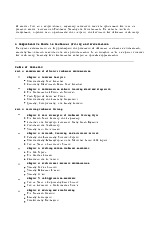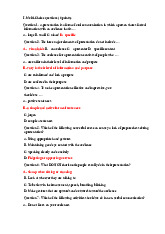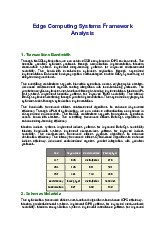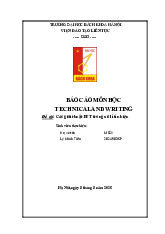





Preview text:
Question 1: A presentation is a form of oral communication in which a person shares factual
information with an audience that is? A. large B. small C. mixed D. specific
Question 2: In presentation design, maximum time is given to the? A. introduction B. conclusion C. main body D. question–answer session
Question 3: To select the content of your presentation, you should know? A. your purpose B. the time limit
C. the audience’s needs
D. the available material
Question 4: What is NOT a good strategy if you are unable to answer a question from an
audience member during your presentation?
A. Acknowledge you don’t know the answer and say the question was irrelevant to the
topic of the presentation
B. Ask others in the audience if they could answer the question
C. Ask the audience member to see you after the presentation so you can understand the question better and answer it
D. Acknowledge you don’t know the answer and would think and get back to the questioner
Question 5: To deal with shoulder hunch and hand clench, which may occur just before you
are due to appear on stage, you are advised NOT to:
A. Consciously relax your shoulders B. Straighten your back
C. Push your chest out and hollow your back
D. Stand as tall as you can or sit with your spine straightened
Question 6: When trying to handle your nerves, remember NOT to do this: A. Slow down B. Breathe calmly
C. Look all around the audience before you start to speak
D. Rush into the seminar room and give a quick look at the audience
Question 7: What should we do with the shoulders when making a presentation? A. Hunch our shoulder B. Slump the shoulders
C. Relax and straighten the shoulders D. Fold arms and shoulders
Question 8: Proper eye contact with the audience when delivering a presentation involves?
A. Looking above the audience’s heads
B. Staring at each audience member
C. Making a sweeping glance of the audience from the left to the right and front to back of the room
D. Making a sweeping glance of the audience from left to right in the front row of the room
Question 9: While giving your presentation, how might you improve the way you are speaking?
A. By varying your pitch and volume to emphasize certain parts of the speech
B. By talking quickly so people feel pumped C. Using jargon
D. Directing your voice primarily at those sat near the front
Question 10: When we want to stress important words we can do it in many ways EXCEPT
for the following: A. We can say them louder
B. We can pause before the important words C. We can make gesture
D. We can say them very quickly
Question 11: You should use ________ and graphs as visuals for data? A. Spreadsheets B. Tables C. Charts D. Words
Question 12: Why should you keep text to a minimum on slides?
A. So the focus is on you as the speaker
B. To help make your presentation longer
C. So the pictures are easier to see
D. To make sure the audience can read everything you have to tell them
Question 13: In a scientific paper, what part is the answer to the research question? A. Introduction B. Method C. Result D. Discussion
Question 14: Which of the following concepts that refers to the “grammatical” aspects of
writing and is focused on the degree to which sentences (or even different parts of a sentence)
are connected so that the flow of ideas is easy to follow? A. Organization B. Coherence C. Cohesion D. Writing Conventions
Question 15: Technical writing usually conveys technical information, instructions, or
explanations to a specific audience. Which of the following is not among the characteristics of technical writing? A. Clarity B. Accuracy C. Structure D. Imaginativeness
Question 16: What kinds of errors in the sentence: “When Jonathan finally found his dog he
was so happy”? A. Verb agreement errors B. Lack of parallel structure
C. Miss comma after an introductory element D. None of the options
Question 17: Which of the following is NOT a reason why proofreading is a writer's final step in document preparation?
A. Proofreading is the responsibility of the manager, not the writer
B. Proofreading detects easily correctable sentence-level errors
C. Proofreading improves the effectiveness of an engaging and informative document
D. Basic errors distract the reader
Question 18: In your research, you shared the contact details of some of your participants
without their prior approval, Which rule are you breaking?
A. Protecting Anonymity and Confidentiality
B. Obtaining Consent Form
C. Avoiding Deceptive Practices D. None of the options
Question 19: Avoiding plagiarism is known to be law of? A. Confidentiality B. Copyright C. Courtesy D. Avoiding copy and paste
Question 20: What should you do in the literature review?
A. Always read the papers in the literature review deeply
B. Look over it quickly to determine whether a paper is relevant
C. Read the papers in the literature review carelessly D. All of the options
Question 21: What can you do to find the research papers?
A. Explore the Web using obvious search keywords
B. Searching on digital libraries such as Wiley, ACM and so on
C. Investigate the references mentioned in promising research papers
D. All above statements
Question 22: How to read a scientific journal article effectively?
A. Start with the introduction
B. Read the introduction first
C. Start with the abstract D. Read the discussion first
Question 23: First step engrossed in writing instruction, regarded as? A. Organization of steps
B. Clarifying the audience
C. Reviewing instruction criteria D. Detail analysis
Question 24: What is the purpose of the evaluation of the research papers?
A. To use these assessments from reviewers to decide whether the paper should be accepted
B. To understand key concepts, terminologies, theories, discoveries, and debates
C. To evaluate the research topic of researchers
D. None of above statements
Question 25: Smallest sections of a technical reports included? A. introduction B. discussion C. abstract D. All of above
Question 26: Each figure within a report should have a title and a number? A. under the figure B. above the figure C. inside the figure D. in page footer
Question 27: The appendixes are parts of? A. Front matter B. Main text C. Glossary D. Back matter
Question 28: We, us and our are examples of? A. Contractions B. Pronoun usage C. Name usage D. Noun
Question 29: Sincerely, is an example of a...? A. Closing Line B. Signature Line
C. Complimentary Closing D. Complimentary Line
Question 30: What are the true statements about résumés and CV?
A. CV contains a lot of information about your accomplishments
B. Résumé is long than CV
C. CV is just a career biography
D. None of the statements



